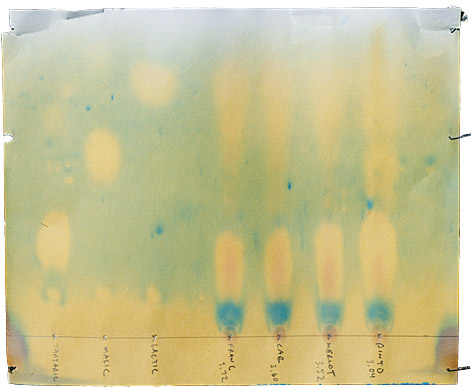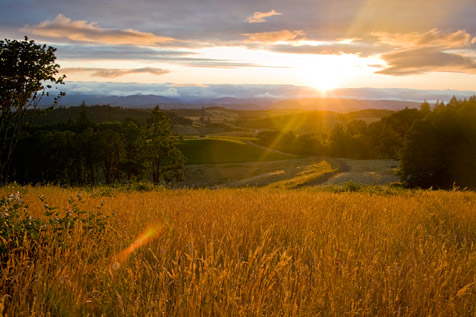Archive for July, 2008
2007 Chroma results
 With fresh reference samples of some acids to work with, I put all four wines through paper chromatography yesterday [what the heck is “paper cro-magni-wha…?”: more background here]. Bask in the aurora borealitic results above.
With fresh reference samples of some acids to work with, I put all four wines through paper chromatography yesterday [what the heck is “paper cro-magni-wha…?”: more background here]. Bask in the aurora borealitic results above.
To the left, along the baseline and on top of those tiny X’s, I placed drops of tartaric, malic and lactic acid, spaced about an inch apart. You’ll note that directly above them there are balloon-like blobs, some closer to the baseline, others closer to the top of the page. If a wine has any of those acids in it, we’d expect to see a blob about the same distance up the page above its X. Crude? Yes. Beautiful? Oh, yeah.
So take a look at the blobs to the right, above drops of the Franc, Cab, Merlot and Pinto. Drawing a horizontal line from the reference blobs on the left, you can see that all of our wines have tartaric acid (not surprisingly), and all have lactic acid. That the Franc, Cab and Merlot don’t have a blob at the malic latitude suggests that all the malic acid in those wines has been converted to lactic acid, so we can assume that malolactic fermentation has finished. Or, in non-science speak, these wines are done fermenting and are more or less safe to bottle without risk of further CO2 bubble production, popping corks down the line and embarrassing Garagistes at parties.
On the far right, however, the Pinto does show some kind of blob at the malic level, though it’s not especially distinct. I took the pH of all our wines prior to running the test (you can see those numbers next to the names), and the Pinto was just a hair above 3, which is pretty acidic (the typical range of wine hits between 3.3 and 3.6). So my guess would be that that much acid has inhibited malolactic fermentation, slowing its progress through this wine. That said, I remember the Pinto tasting great (and not “acidic”), so I’m not sure what to make of or do with this result. Is malo stuck, or simply taking its time? Dunno.
In any case, the reason I ran the test in the first place is for the Franc, whose results indicate malolactic is over and we can therefore trust the acid numbers we got earlier. So in the next day or so, I’ll be adding SO2 and some acid to try to perk up our old friend.
1 commentFranc-ly Puzzling
As I wrote a few days ago, the Cabernet Franc — long our favorite wine from our grower — wasn’t its usual self at last racking. While it’s been dependably fresh and lovely any time we pull it from barrel, last week it was dull and flat, seemingly absent the will to live. A little unsettling, to say the least.
Today I got back some lab results from our long-suffering friends at ETS Labs, so we have a better picture of what’s going on with this sullen teenager. But even as the data answers some questions, it raises some others.
Stroke your beard and consider a theory or two with me after the jump…
Read more
The View from Oracle
 Looking west from the lower, still-to-be-planted part of Westrey‘s Oracle Vineyard
Looking west from the lower, still-to-be-planted part of Westrey‘s Oracle Vineyard
The 2007 at June racking
 A few nights ago we got together to rack our three wines, and of course, couldn’t help tasting them as they poured from barrel to tank and back into barrel.
A few nights ago we got together to rack our three wines, and of course, couldn’t help tasting them as they poured from barrel to tank and back into barrel.
2007 Cabernet Franc
I think the consensus was that contrary to any of our previous experiences with this wine at this stage, the Franc showed the worst of the three. It had a decent fragrance, but it was murky and lifeless in the mouth, oddly framed with a hint of oak (it’s in an essentially neutral barrel). And once past the tonsils, it was like it was never there. Overall, a far cry from the fresh, precocious party-in-your-mouth the Franc usually is — and the way it was in March, when last we racked it.
So, what’s going on? Theories abound — more in a future post — but it’s certainly true that most wines go through “dumb” or hibernative stages, where between one chemical state and another they’re kind of in limbo. I think of it like a construction project: you begin with one thing (nice bones, but what Nazi scientist designed that wallpaper!?), but before the shiny new thing emerges (did you notice it matches my iTouch?), you float like Dante through the undoing of one and the creation of the other, where your thing isn’t what it was, but it isn’t what it’ll become. It’s something, yet it’s also not quite anything, either. And you have to use a port-a-potty in the back yard for a month.
Anyway, that’s not unusual for wine as it evolves (for example, see my notes on the Sauvignon, below), but it’s not how the Franc has ever performed in the past. More soon.
Cabernet Sauvignon
Next up was the Cab. It was also a little shuttered, but more in a way you’d expect at this stage in its life. All the stuffing was there, and indeed, it had a lot of complexity and good feel in the mouth, though not much of a finish that night. All in all, however, showed pretty good life for so young a wine, and all present murmured approval into their cups.
Merlot
If you’ve got a weak heart, please skip the second half of this sentence: the merlot was the best wine of the evening. I’ll give you a minute to get your bearings. Sometimes a glass of wine helps.
While it lacked a little backbone (though in point of fact, it showed the backbone of a good Merlot), it betrayed surprising life, in addition to a bass marimba-like depth and velvetyness in the mouth. Almost complex, and a pretty good ride through the finish.
If this is in fact representative of where the Merlot will end up (no guarantees there, of course), I’d say this is due to a combination of three things: 1) wild yeast (so many gene pools, so many flavors); 2) crop load (we asked the grower to dramatically reduce yield in 2007: and 3) pulling a seignée out of it (in a nutshell, a seignée drains juice from a fermenter, increasing the proportion of flavor-packed skins to tasty juice). I’d give more of a nod to 2 and 3 than 1, but probably all played a role.
Next up is blending, so we’ll see if this was an aberration or a strategy worth repeating.
No comments
